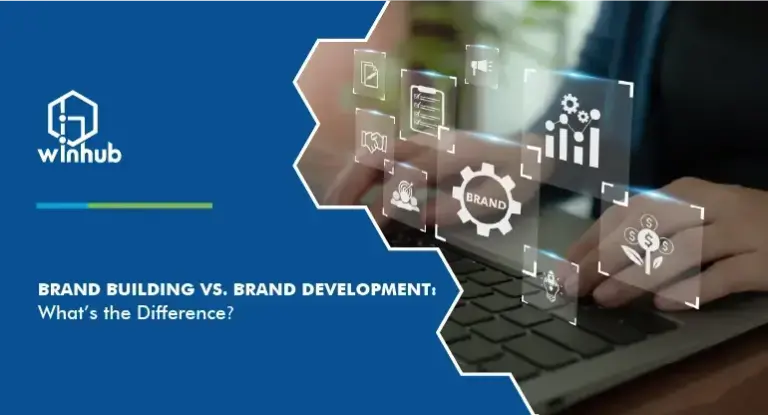Now that we’ve explored the 5 essential steps to kickstart your brand development process, it’s time to delve into another crucial aspect of branding: the difference between brand building and brand development.
While these terms are often used interchangeably, they represent distinct stages in creating and nurturing a successful brand. As a small business owner, understanding the difference between brand building and brand development can help you strategically navigate your brand’s journey, ensuring you establish a strong foundation and continuously evolve and grow your brand in a competitive market.
In this blog, we’ll unpack the key differences, objectives and strategies behind brand building and brand development to help you maximize your small business’s potential.
The Essence of Brand Building
Brand building is the phase where you establish your brand’s identity and presence in the market. It’s about creating awareness and making your brand recognizable to your target audience. This process involves defining your brand’s core values, mission and vision, and effectively communicating them to the world.
For a small business, brand building starts with identifying what makes you unique. What is your story? What values drive your business? Brand building is about sharing these aspects with your audience in a way that resonates deeply with them. In this stage, you lay the groundwork for how your brand will be perceived!
Key Elements of Brand Building Include:
- Creating a Strong Visual Identity: Your logo, color scheme and overall design should be cohesive and reflect your brand’s personality. This visual identity will be the face of your brand, making it instantly recognizable.
- Crafting a Compelling Brand Story: Your brand story should connect emotionally with your audience (Forbes). Stories that resonate with consumers are the ones most likely to stay in their minds Share the journey of how your small business came to be, what challenges you’ve overcome and what drives you forward.
- Building Brand Awareness: Utilize various marketing channels such as social media, content marketing and advertising to introduce your brand to your target audience. Consistency is key in ensuring your brand remains at the forefront of consumers’ minds!
Example of a Brand Story: Patagonia

Patagonia’s “Don’t Buy This Jacket” campaign, launched in 2011, was a bold statement against consumerism and a call to action for environmental responsibility. The campaign featured an image of one of their best-selling jackets with the tagline urging consumers to consider the environmental impact before making a purchase. This unconventional approach resonated deeply with consumers who appreciated Patagonia’s commitment to sustainability and transparency.
It reinforced its brand story as a company dedicated to producing high-quality outdoor gear and advocating environmental conservation. By challenging traditional marketing tactics, Patagonia positioned itself as a leader in ethical consumerism and strengthened its connection with environmentally conscious consumers worldwide.
The Journey of Brand Development
While brand building is about establishing your brand’s presence, brand development focuses on growing and evolving that brand over time. It’s an ongoing process that involves refining and enhancing your brand’s identity, ensuring it remains relevant and resonant with your audience.
Brand development is crucial for small businesses looking to maintain a strong position in a competitive market. It prioritizes continuous engagement with your audience, adapting to changes in the market and consistently delivering on your brand promise.
Key Elements of Brand Development Include:
- Engaging with Your Audience: Regularly interact with your customers to understand their needs and preferences. This is easy to do on social media platforms, such as LinkedIn, Instagram and X. Use feedback to improve your products or services and show that you value their input.
- Evolving Your Brand Identity: As your business grows, your brand identity may need to evolve. This could involve rebranding efforts such as updating your logo, redesigning your website or tweaking your messaging to better align with your current values and goals.
- Maintaining Brand Consistency: Ensure that all aspects of your brand, from your marketing materials to customer service interactions, are consistent and reflect your brand values. Consistency builds trust and reinforces your brand’s credibility (LinkedIn).
The Interplay Between Brand Building and Brand Development
For small businesses, the interplay between brand building and brand development is a dynamic and continuous process. Initially, brand building lays the foundation by establishing who you are and what you stand for. As your business grows, brand development takes over, ensuring that your brand remains relevant and continues to resonate with your audience.
Consider the example of a small coffee shop. In the brand building phase, the focus would be on creating a unique brand identity—perhaps emphasizing locally sourced ingredients, handcrafted brewing methods and a cozy, community-focused atmosphere. The brand building process would involve designing a distinctive logo, creating a warm and inviting shop interior and launching a marketing campaign to introduce the coffee shop to the local community.
As the coffee shop gains customers and popularity, the focus shifts to brand development. This could involve engaging with regular customers through loyalty programs, gathering feedback to improve the menu and expanding the brand’s presence online through social media and a user-friendly website. The goal of brand development is to keep the brand fresh and relevant, ensuring that customers remain loyal and new customers are continually attracted to the business.
The Importance of Both Processes for Small Businesses
For small businesses, both brand building and brand development are crucial for long-term success. Neglecting brand building can result in a lack of awareness and recognition, making it difficult to attract and retain your customers. On the other hand, neglecting brand development can lead to stagnation, causing your brand to lose relevance and connection with your audience.
Investing time and resources in both processes ensures that your brand not only makes a strong initial impact but also continues to grow and evolve alongside your small business. It’s a balanced approach that combines the excitement of introducing your brand to the world with the strategic effort required to keep it thriving.
Understanding the difference between brand building and brand development is essential for small businesses aiming for long-term success. Brand building sets the stage by establishing your brand’s identity and presence, while brand development ensures that your brand continues to grow, evolve and resonate with your audience. Embracing both processes allows you to create a strong, enduring brand that stands out in a competitive market and drives lasting success!
Need help getting started or have questions? Contact WinHub today!



